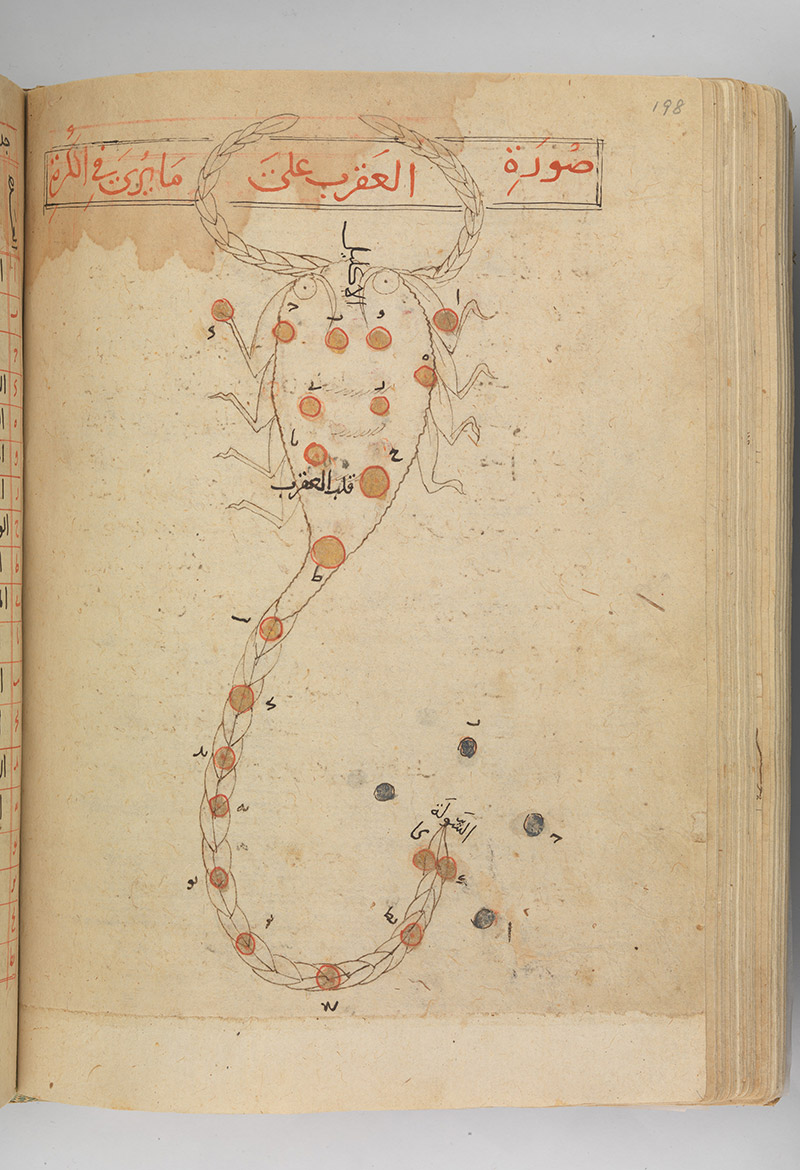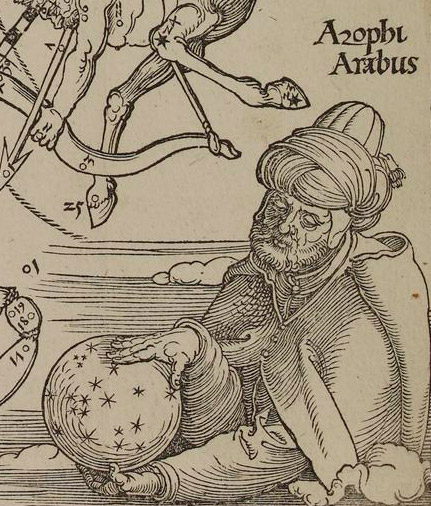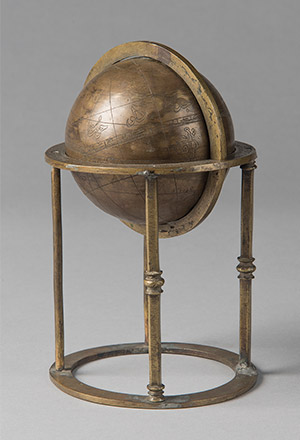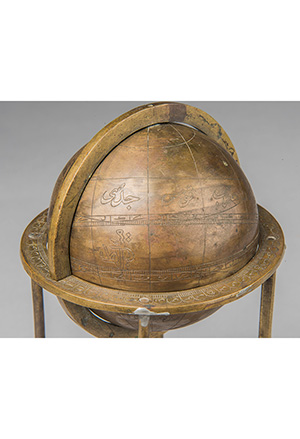Stars and Constellations: al-Ṣūfī (d.986)
10th century Shiraz and Isfahan

- كتاب صور الكواكب الثابتة
- عبد الرحمن بن عمر الصوفي
- Kitāb Ṣuwar al-kawākib al-thābitah.
- ʿAbd al-Raḥmān ibn ʿUmar al-Ṣūfī (d.986).
- Copied late 15th century?
- Arabic.
- Manuscript codex on paper, p.197.
- Met 13.160.10 (The Metropolitan Museum of Art, New York).

- كتاب صور الكواكب الثابتة
- عبد الرحمن بن عمر الصوفي
- Kitāb Ṣuwar al-kawākib al-thābitah.
- ʿAbd al-Raḥmān ibn ʿUmar al-Ṣūfī (d.986).
- Copied late 15th century?
- Arabic.
- Manuscript codex on paper, p.198.
- Met 13.160.10 (The Metropolitan Museum of Art, New York).

- Celestial globe.
- Iran, 18th century?
- Metal alloy.
- GL-1.

- Celestial globe (detail).
- Iran, 18th century?
- Metal alloy.
- GL-1.
This image of the constellation Scorpio appears in a 15th century copy of Kitāb Ṣuwar al-kawākib al-thābitah (Book of the Images of the Fixed Stars), an influential Arabic treatise on the constellations authored by the famed Iranian astronomer ʿAbd al-Raḥmān ibn ʿUmar al-Ṣūfī (d.986).
In this treatise, al-Ṣūfī presents the forty-eight classical constellations catalogued by Ptolemy in the Almagest (ca. 150 CE). For each constellation, al-Ṣūfī provides a description of the figure and its stars — including old Arabic star names for the corresponding Ptolemaic stars, a table of coordinates and magnitudes for each star — the coordinates being those of Ptolemy adjusted for precession but the magnitudes of his own observation, and drawings depicting two views — one as seen in the sky, the other as seen on the celestial globe (actually a mirror image of the first). He apparently also makes the earliest known mention by an astronomer of the Andromeda Nebula. (cf Kunitzsch 1987)
al-Ṣūfī’s approach became a model for later astronomers and instrument makers working in the Arabic-Islamic astronomical traditions, with his star catalogue an incredibly important source. A Persian translation by Naṣīr al-Dīn Ṭūsī (d.1274) was consulted in the preparation of the novel star catalogue of Ulugh Beg’s (d.1449) astronomical handbook Zīj-i jadīd-i sulṭānī. Notably, the star catalogue prepared for Ulugh Beg relied on al-Ṣūfī’s magnitudes but provided star positions based on new, independent measurements rather than simply adjusting the coordinates of Ptolemy.
In Europe, al-Ṣūfī was cited under the name Azophi from the 12th century, with his constellation treatise appearing in full Spanish recension in the 13th century and subsequent Italian translation (14th century).

The star catalogue of al-Ṣūfī was an important source for manufacturers of celestial globes. (cf Savage-Smith 1985 p23 ff) A celestial globe models celestial phenomena by mapping the arrangement and movement of the stars as seen by an observer outside the sphere of fixed stars. Thus the relative positions on a celestial globe are the reverse of their appearance as observed from the surface of the earth. Celestial globes appear to have emerged in Greek antiquity and were most likely used by astronomers in the Hellenistic period, such as Hipparchus (ca. 150 BCE).
This celestial globe includes neither stars nor constellation figures, but does include zodiacal names along the ecliptic in large script. Here visible along the ecliptic are عقرب (Scorpio), قوس (Sagittarius), and جدي (Capricorn). Further included are ecliptic latitude circles, celestial equator, equinoctial colure, equatorial and ecliptic polar circles, equatorial and ecliptic tropic circles. The circles and intersections are carefully executed but the graduations are uneven.
The sphere is of a metal alloy and likely a Persian product of the 18th century. It now rests on rings and stand which were made for a different globe and probably of Indo-Persian manufacture.
Select Bibliography
- The MET Online catalogue record for “Kitab suwar al-kawakib al-thabita (Book of the Images of the Fixed Stars) of al-Sufi” Met 13.160.10.
- Kunitzsch, Paul. “ʿAbd al-Raḥmān al-Ṣūfī.” Encyclopaedia of Islam THREE, edited by Kate Fleet et al.
- Kunitzsch, Paul. 1987. “A Medieval Reference to the Andromeda Nebula.” ESO Messenger 49: 42–3.
- Maddison, Francis, and Emilie Savage-Smith. 1997. Science, Tools, & Magic Part One: Body and Spirit, Mapping the Universe (= Nasser D. Khalili Collection of Islamic Art, v. 12). London: The Nour Foundation in association with Azimuth Editions and Oxford University Press.
- Savage-Smith, Emilie. “Islamic celestial globe, Inv. No. GL-1,” Descriptive notes on the Historic Scientific Instruments Collection, Special Collections administrative files.
- Savage-Smith, Emilie. 1985. Islamicate Celestial Globes: Their History, Construction, and Use. Washington, DC: Smithsonian Institution Press (available online)
- van Gent, R. H. Al-Ṣūfī’s Book of the Constellations of the Fixed Stars and its Influence on Islamic and Western Celestial Cartography. (available online), last updated October 2021.



